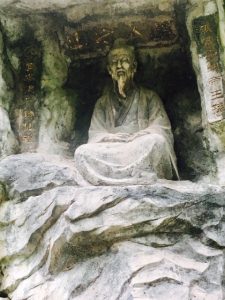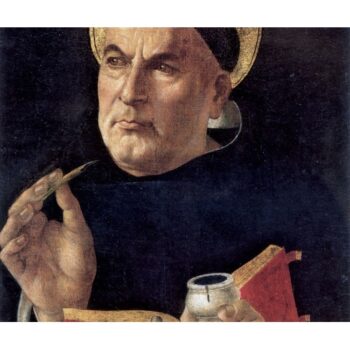Laozi sculpture (Taishan, China)
Along with Confucius, Laozi is one of the two main thinkers of importance in the history of Chinese philosophy. In early periods of Chinese history the philosophies of the two schools to develop from their thought (Confucianism and Taoism) are viewed as in rivalry. However, in the Middle Ages, a syncretism developed between Confucianism, Taoism, and Buddhism. Ideas from each of these philosophical schools were thought to have an appropriate place in a balanced life.
There is much legend surrounding the life of Laozi. Some have even questioned whether he lived at all. Most however accept that he did live at around the same time as Confucius, in the 6th century BCE. While Confucius, however, develops what is largely a social theory, the focus of Laozi is on a metaphysics and individual ethics.
Laozi and the Tao te Ching — Introduction
It is difficult to know what precisely Laozi (also Lao Tzu) thought. Though according to legend he was the author of the Tao te Ching, scholars now know this isn’t the case. Stylistically, the various parts of the book differ too extremely from one another. In addition, some of the aphorisms in the book are known to have pre-dated the 6th century BCE when he is thought to have lived. The text is generally thought to have been completed in the 3rd century BCE. It may well be that going back in Chinese history, the aphorisms in the Tao te Ching became part of an oral culture, passed on among groups of Taoists (Kahenmark, 13-15) . The Tao te Ching is the most translated book in the world except for the bible. And there have been over 200 commentaries on the work since it was written (Kahenmark, 16). For the sake of convenience, I will here attribute the ideas of the Tao te Ching to the legendary Laozi.
The Tao
Laozi is known for the emphasis on the Tao. Translated variously as the way, or nature’s way, there were two main characteristics of the Tao. It was used as a verb “to direct,” “to guide,” or “to establish communication” (K, 22) As a noun it was used to refer to the order of nature familiar in the patterns of seasons and the alterations between night and day and so on. The Tao was thought to reflect the complimentary oppositions of the yin and yang, principles of the cosmic order, which became associated with female and the male, the dark and the light, the cold and the hot, the damp and the dry. In Taoism, this idea of nature’s balancing of oppositions takes on a greater clarity than in the Heraclitian or ancient Greek world generally.
A focus of Laozi, however, becomes to guide or direct or show the way for individuals to establish a conscious connection with this cosmic order. In the main Laozi emphasizes an ethics or, even more broadly, a general form of life, that will create the means of communication with the Tao, with nature’s Way.
Laozi emphasizes the reality is a dynamic process (cp. K, 26). However, the precise character of the process remains somewhat unclear.
The Unknowable Tao
As the Tao te Ching opens: “The Tao that can be trodden is not the enduring and unchanging Tao. The name that can be named is not the enduring and unchanging name.” (Tao te Ching, 1)
The Tao is a reality that Laozi does not think can be known absolutely. The unchanging Tao is beyond human categorization and conceptualization. The concepts we develop for it, and this would apply to those like Yin and Yang and the concepts that we use to describe its process, have a contingency and incompleteness.
The Tao as mother of all things
That said, the Tao te Ching goes on to describe quite a lot. “(Conceived of as) having no name, it is the Originator of heaven and earth; (conceived of as) having a name, it is the Mother of all things” (Tao te Ching, 1). The Tao is thought to pre-exist all things. It is the source of creation.
Yet, while the Tao is the source of all things, it is not for that a separate creator: “All things depend on it for their production, which it gives to them, not one refusing obedience to it. When its work is accomplished, it does not claim the name of having done it. It clothes all things as with a garment, and makes no assumption of being their lord…” (Tao te Ching, 34).
The Tao is best conceived as a foundation of all reality, as a system in flux, but unfolding with certain regularities.
Balancing oppositions
The Tao in the Tao te Ching, like the cosmos in thought of the Ancient Greek Philosopher Heraclitus, is viewed as fundamentally in process as oppositions are balanced. “The movement of the Tao by contraries proceeds” (Tao te Ching, 40). Or as Chapter 2 already notes: “All in the world know the beauty of the beautiful, and in doing this they have (the idea of) what ugliness is; they all know the skill of the skillful, and in doing this they have (the idea of) what the want of skill is.” On the one hand, here the emphasis is on the balance of oppositions in the world. On the other, the focus is also on the inevitability of oppositions for our conceptual understanding. We do not know the beautiful without a concept of the ugly, and so on.
Emptiness
While highlighting the oppositions that comprise the Tao with a great clarity, the Tao te Ching also focuses on emptiness and nothingness. “The Tao is (like) the emptiness of a vessel; and in our employment of it we must be on our guard against all fullness” (Tao te Ching, 4). Or, for a text emphasizing emptiness in multiple contexts: “The thirty spokes unite in the one nave; but it is on the empty space (for the axle), that the use of the wheel depends. Clay is fashioned into vessels; but it is on their empty hollowness, that their use depends. The door and windows are cut out (from the walls) to form an apartment; but it is on the empty space (within), that its use depends. Therefore, what has a (positive) existence serves for profitable adaptation, and what has not that for (actual) usefulness” (Tao te Ching, 11). Nonbeing is as fundamental or more fundamental than Being in Taoism, as in Buddhism.
Intuition and its critical limitations
Laozi is known for emphasizing the need for a mental intuition in order to achieve this understanding of the Tao. In this he downplayed very much the importance of education, which he saw as indoctrinating individuals into preconceived views of what is right and wrong and to limited views of reality.
Laozi was thus not known for encouraging an empirical and rational critical outlook. Xunzi, the third century BCE Confucian scholar criticized him saying “Lao Tzu understood looking inward but knew nothing of looking outward” (Qtd. in Kahenmark, 20). Early sources maintain that he was gifted with a spiritual intuition. As noted in the Chaung Tzu, he, along with Kuan Yin “made [their teaching’s] basic principle the Permanent Unseen and its ruling idea the Supreme One. Their outward demeanor was gentle and accommodating; their inward principles were perfect emptiness and noninjury to all living creatures” (Chapter 33, Qtd. in Kahenmark, 21).
The epistemology at work in Laozi is more instrumentalist than realist. Named things have a contingent use value. But it is not through reflective analysis that we will know the law of balance of the Tao, or the order of the cosmos. It is a spiritual intuition that leads to a more reliable kind of knowledge. The harmony with the Tao is not achieved through discursive reason. Rather, it is achieved through a spiritual insight.
Ethics and political thought
This insight of the unity of all things in the Tao also has its benefits for the ethical life. Comprehending this unity, individuals do not assert their own ego interests above that of others. Rather they willingly engage in cooperation with one another. The Taoists tended to emphasize a fundamental goodness of human nature. For this reason, they opposed a heavy handed legalist framework. In the view of the Taoists, laws were not necessary to generate civility or cooperation among people. They thus argued for a minimalist political framework. “Governing a small country is like frying a small fish. You ruin it by poking too much” (70). Too much government would, in Laozi’s view, cause more problems than it solved: “The more restrictions and prohibitions there are, the poorer the people will be” (57).
The ideal of Laozi, however, is small village life. One might wonder whether the rather lassie faire political philosophy works well in cosmopolitan cities with individuals who do not share common cultural ideals or in other general contexts of global governance.
Go to Chapter 5, The Pre-Socratics
Some helpful links
Laozi — The School of Life Video

